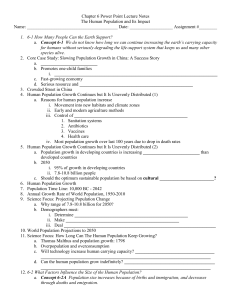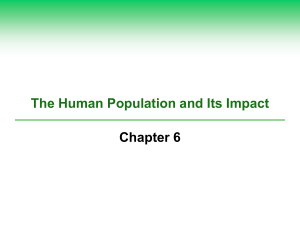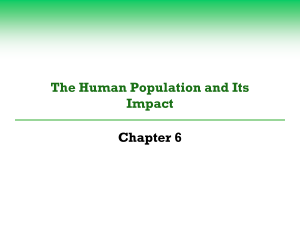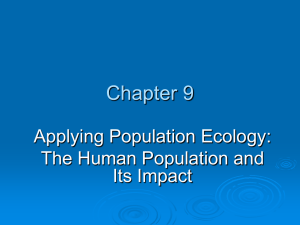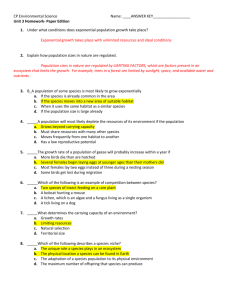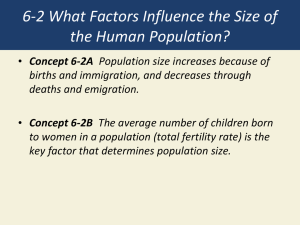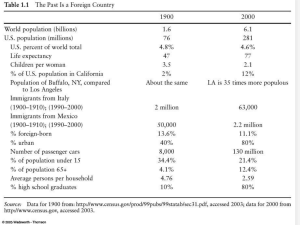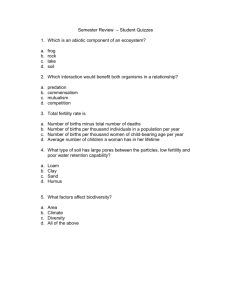Chapter 1 Environmental Problems, Their Causes, and Sustainability
advertisement
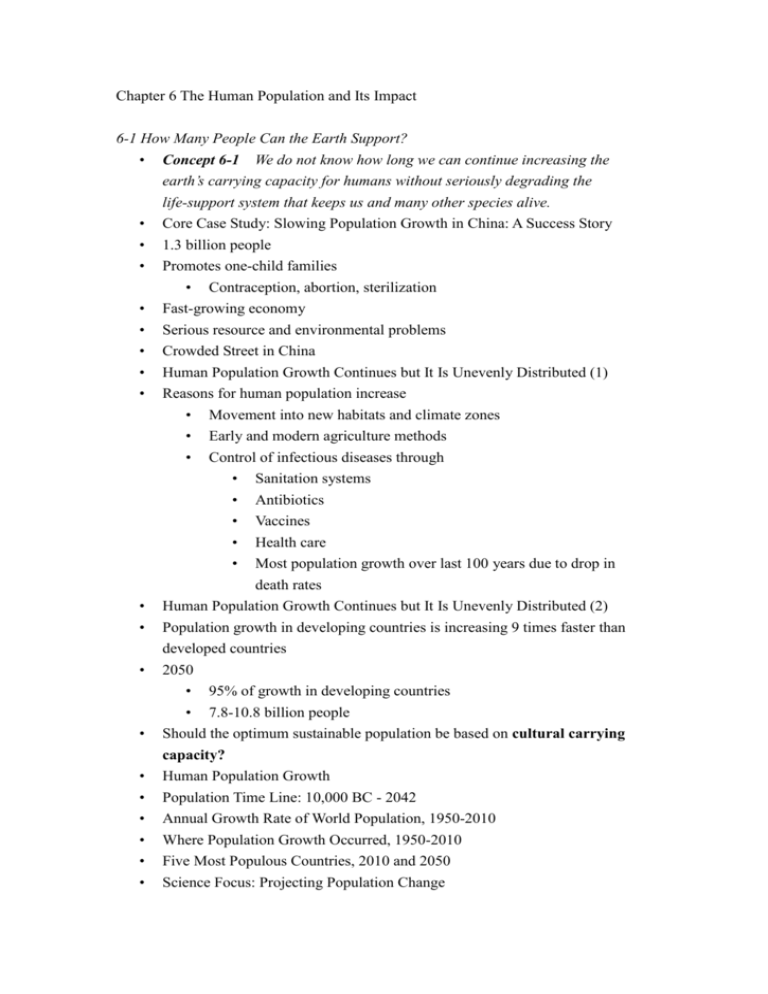
Chapter 6 The Human Population and Its Impact 6-1 How Many People Can the Earth Support? • Concept 6-1 We do not know how long we can continue increasing the earth’s carrying capacity for humans without seriously degrading the life-support system that keeps us and many other species alive. • Core Case Study: Slowing Population Growth in China: A Success Story • 1.3 billion people • Promotes one-child families • Contraception, abortion, sterilization • Fast-growing economy • • • Serious resource and environmental problems Crowded Street in China Human Population Growth Continues but It Is Unevenly Distributed (1) • Reasons for human population increase • Movement into new habitats and climate zones • Early and modern agriculture methods • Control of infectious diseases through • Sanitation systems • Antibiotics • Vaccines • • • • • Health care Most population growth over last 100 years due to drop in death rates Human Population Growth Continues but It Is Unevenly Distributed (2) Population growth in developing countries is increasing 9 times faster than developed countries 2050 • 95% of growth in developing countries • 7.8-10.8 billion people • Should the optimum sustainable population be based on cultural carrying • • • • • • capacity? Human Population Growth Population Time Line: 10,000 BC - 2042 Annual Growth Rate of World Population, 1950-2010 Where Population Growth Occurred, 1950-2010 Five Most Populous Countries, 2010 and 2050 Science Focus: Projecting Population Change • Why range of 7.8-10.8 billion for 2050? • • • • • • • Demographers must: • Determine reliability of current estimates • Make assumptions about fertility trends • Deal with different databases and sets of assumptions World Population Projections to 2050 Science Focus: How Long Can The Human Population Keep Growing? Thomas Malthus and population growth: 1798 Overpopulation and overconsumption Will technology increase human carrying capacity? Can the human population grow indefinitely? • Natural Capital Degradation: Altering Nature to Meet Our Needs 6-2 What Factors Influence the Size of the Human Population? • • • • Concept 6-2A Population size increases because of births and immigration, and decreases through deaths and emigration. Concept 6-2B The average number of children born to women in a population (total fertility rate) is the key factor that determines population size. The Human Population Can Grow, Decline, or Remain Fairly Stable Population change • • • Births: fertility Deaths: mortality Migration • Population change = (births + immigration) – (deaths + emigration) • • • Crude birth rate: # live births/1000/year Crude death rate: # deaths/1000/year Women Having Fewer Babies but Not Few Enough to Stabilize the World’s Population • Fertility rate • number of children born to a woman during her lifetime • Replacement-level fertility rate • Average number of children a couple must have to replace themselves • 2.1 in developed countries • Up to 2.5 in developing countries • Total fertility rate (TFR) • Average number of children born to women in a population • Total fertility rate, 1955-2010 • • • • • • 2010 Rate of Population Increase Case Study: The U.S. Population Is Growing Rapidly Population still growing and not leveling off • 76 million in 1900 • 310 million in 2010 Drop in TFR in U.S. • Rate of population growth has slowed Changes in lifestyle in the U.S. during the 20th century U.S. TFRs and birth rates 1917-2010 Several Factors Affect Birth Rates and Fertility Rates (1) • • • Children as part of the labor force Cost of raising and educating children Availability of private and public pension • • • • • • • Urbanization Educational and employment opportunities for women Several Factors Affect Birth Rates and Fertility Rates (2) Average age of a woman at birth of first child Availability of legal abortions Availability of reliable birth control methods Religious beliefs, traditions, and cultural norms • Several Factors Affect Death Rates (1) • • Life expectancy Infant mortality rate • Number of live births that die in first year Why are people living longer? • Increased food supply and distribution • Better nutrition • Medical advances • Improved sanitation • • • • • • Several Factors Affect Death Rates (2) U.S. is 54th in world for infant mortality rate U.S. infant mortality rate high due to • Inadequate health care for poor women during pregnancy and their infants • Drug addiction among pregnant women • High birth rate among teenagers Migration Affects an Area’s Population Size • Economic improvement • • • • • • • • • Religious freedom Political freedom Wars Environmental refugees Case Study: The United States: A Nation of Immigrants Historical role of immigration in the U.S. Legal immigration Illegal immigration Controversy over immigration policy 6-3 How Does a Population’s Age Structure Affect Its Growth or Decline? • Concept 6-3 The numbers of males and females in young, middle, and older age groups determine how fast a population grows or declines. • A Population’s Age Structure Helps Us Make Projections • Age structure categories • Prereproductive ages (0-14) • Reproductive ages (15-44) • Postreproductive ages (45 and older) • Seniors are the fastest-growing age group Case Study: The American Baby Boom • • • • • • 79 million people, 36% of adults Affect politics and economics Now becoming senior citizens • Graying of America • Populations Made Up of Mostly Older People Can Decline Rapidly Slow decline • Manageable Rapid decline • • Severe economic problems • How pay for services for elderly • Proportionally fewer young people working • Labor shortages • Severe social problems • Populations Can Decline from a Rising Death Rate: The AIDS Tragedy 27 million killed: 1981-2009 • Many young adults die: loss of most productive workers • • Sharp drop in life expectancy International community • Reduce the spread of HIV through education and health care • Financial assistance and volunteers 6-4 How Can We Slow Human Population Growth? • Concept 6-4 We can slow human population growth by reducing poverty, elevating the status of women, and encouraging family planning. • As Countries Develop, Their Populations Tend to Grow More Slowly • • • • • • Demographic transition • First death rates decline • Then birth rates decline • Four stages • Preindustrial • Transitional • Industrial • Postindustrial Empowering Women Can Slow Population Growth Factors that decrease total fertility rates: • Education • Paying jobs • Ability to control fertility Women • Do most of the domestic work and child care • Provide unpaid health care • 2/3 of all work for 10% of world’s income • Discriminated against legally and culturally Promote Family Planning Family planning in less-developed countries • • • • • • Responsible for a 55% drop in TFRs Financial benefits: money spent on family planning saves far more in health, education costs Two problems 42% pregnancies unplanned, 26% end with abortion Many couples do not have access to family planning Case Study: Slowing Population Growth in India • 1.2 billion people, most populous country in 2015 • Problems • Poverty • Malnutrition • Environmental degradation • Bias toward having male children • Poor couples want many children • Only 48% of couples use family planning • Three Big Ideas 1. The human population is increasing rapidly and may soon bump up against environmental limits. 2. Even if population growth were not a serious problem, the increasing use of resources per person is expanding the overall human ecological footprint and putting a strain on the earth’s resources. 3. We can slow population growth by reducing poverty through economic development, elevating the status of women, and encouraging family planning.
